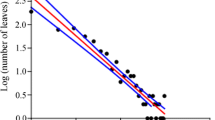Summary
Pryeria sinica (Zygaenidae) larvae feed on young and growing leaves of Euonymus japonicus in groups. The larvae often defoliate their host plant. Hence, the larvae are occasionally subject to serious shortage in food resources. We hypothesize that larval aggregation is an adaptation for the economical utilization of limited food resources. To test this hypothesis, the patterns of resource utilization were studied on larvae settled on shoots of host plant in various group sizes. The amount of food resources in a shoot was affected by the following three factors; (1) shoot growth, (2) food consumption of larvae, and (3) inhibition of growth or degeneration of shoot by larval activity on it. These factors were measured and the efficiency in resource utilization was compared among groups of varied sizes. The loss in resources caused by the third factor was found to be decreased with group size, i.e., the larger the group size, the larvae utilized the food resources more economically. The advantages of group feeding in survival and reproduction of this species were discussed using a simple graphical model.
Similar content being viewed by others
References
Bertram BCR (1978) Living in groups: Predators and prey. In: Krebs JR, Davies NB (ed) Behavioural ecology: an evolutionary approach. Blackwell, London, pp 64–96
Charnov EL, Orians GH, Hyatt K (1976) The ecological implications of resource depression. Amer Natur 110:247–259
Cody ML (1971) Finch flocks in the Mohave desert. Theor Popul Biol 2:142–158
Fisher J (1954) Evolution and bird sociality. In: Huxley JS, Hardy AC, Ford EB (ed) Evolution as a process. Allen and Unwin, London, pp 71–83
Ghent AW (1960) A study of the group-feeding behaviour of larvae of the jack pine sawfly, Neodiprion pratti bankskisianae Rho. Behaviour 16:110–148
Heinrich B (1978) The economics of insect sociality. In: Krebs JR, Davies NB (ed) Behavioural ecology: An evolutionary approach. Blackwell, London, pp 97–128
Horn HS (1968) The adaptive significance of colonial nesting in the Brewer's blackbird (Euphagus cyanocephalus). Ecology 49:682–694
Howell DJ (1979) Flock foraging in nectar-feeding bats: Advantages to the bats and to the host plants. Amer Natur 114:23–49
Krebs JR (1974) Colonial nesting and social feeding as strategies for exploiting food resources in the great blue heron (Ardea herdias). Behaviour 51:99–134
Kruuk H (1972) The spotted hyaena. University of Chicago Press, Chicago
Kruuk H (1975) Functional aspects of social hunting by carnivores. In: Baerends G, Beer C, Manning A (ed) Function and evolution in behaviour. Oxford University Press, London, pp 119–141
Morimoto N (1979) Adaptive significance of aggregative behaviour. In: Ishii S, Ooshima C, Tateda H, Hidaka T (eds), Behaviour and life history of insects. Baihuukan, Tokyo, p 33–70 (in Japanese)
Murton RK (1971) The significance of a specific search image in the feeding behaviour of the wood pigeon. Behaviour 40:10–42
Oster GF, Wilson EO (1978) Caste and ecology in the social insects. Princeton University Press, Princeton
Shaller GB (1972) The Serengeti lion. Chicago University Press, Chicago
Siegfried WR (1971) Communal roosting of the cattle egret. Trans R Soc S Afr 39:419–443
Tsubaki Y (1981) Some beneficial effects of aggregation in young larvae of Pryeria sinica Moore (Lepidoptera: Zygaenidae). Res Popul Ecol 23:156–167
Tsubaki Y, Yamamura N (1980) A model descriptive of gregariousness of colonial insect larvae. Res Popul Ecol 21:332–344
Waldbauer GP (1968) The consumption and utilization of food by insects. Adv Insect Physiol 5:88–208
Ward P (1965) Feeding ecology of the black-faced dioch Quelea quelea in Nigeria. Ibis 107:173–214
Ward P, Zahavi A (1973) The importance of certain assemblages of birds as ‘information centers’ for food finding. Ibis 115:517–534
Zahavi A (1971) The function of pre-roost gatherings and communal roosts. Ibis 107:173–214
Author information
Authors and Affiliations
Rights and permissions
About this article
Cite this article
Tsubaki, Y., Shiotsu, Y. Group feeding as a strategy for exploiting food resources in the burnet moth Pryeria sinica . Oecologia 55, 12–20 (1982). https://doi.org/10.1007/BF00386712
Received:
Issue Date:
DOI: https://doi.org/10.1007/BF00386712




